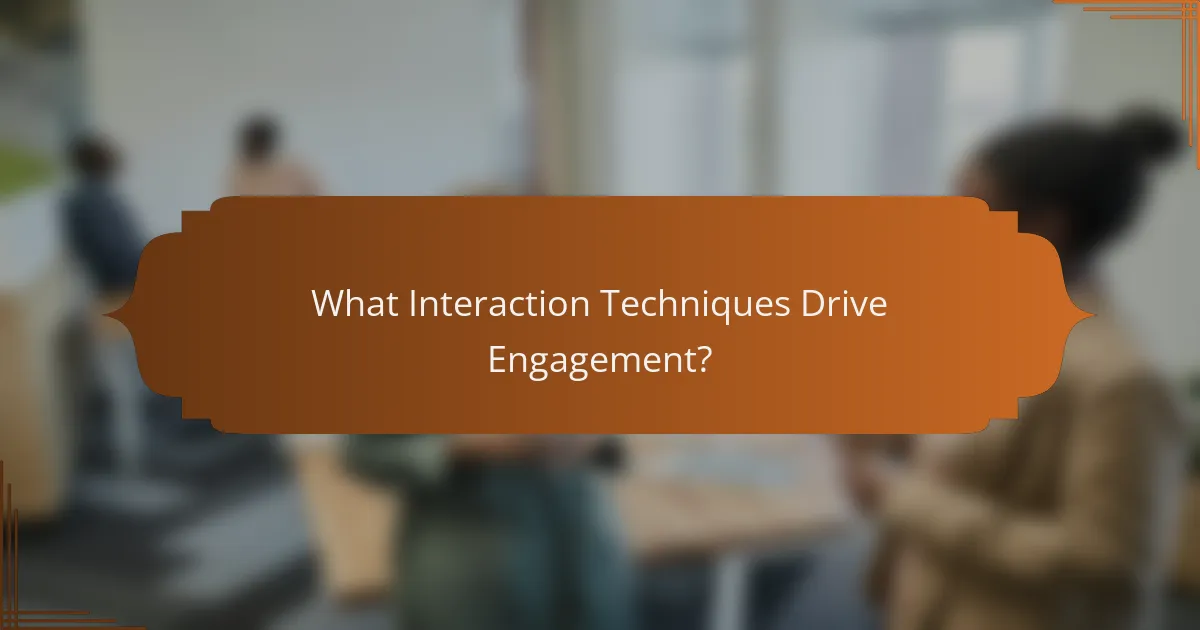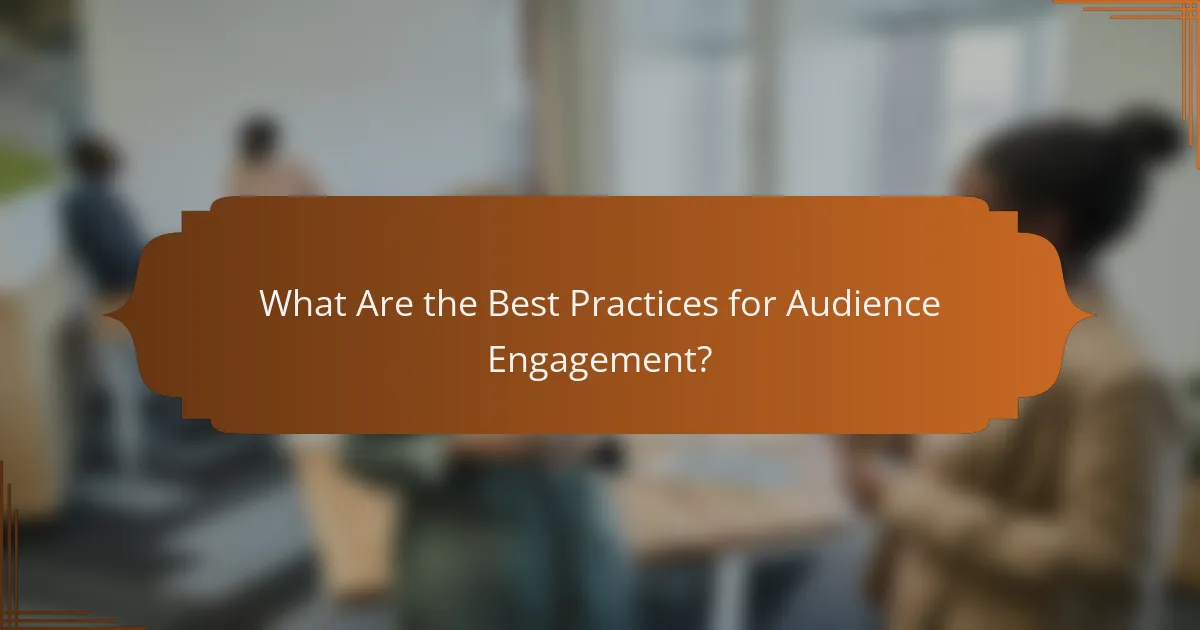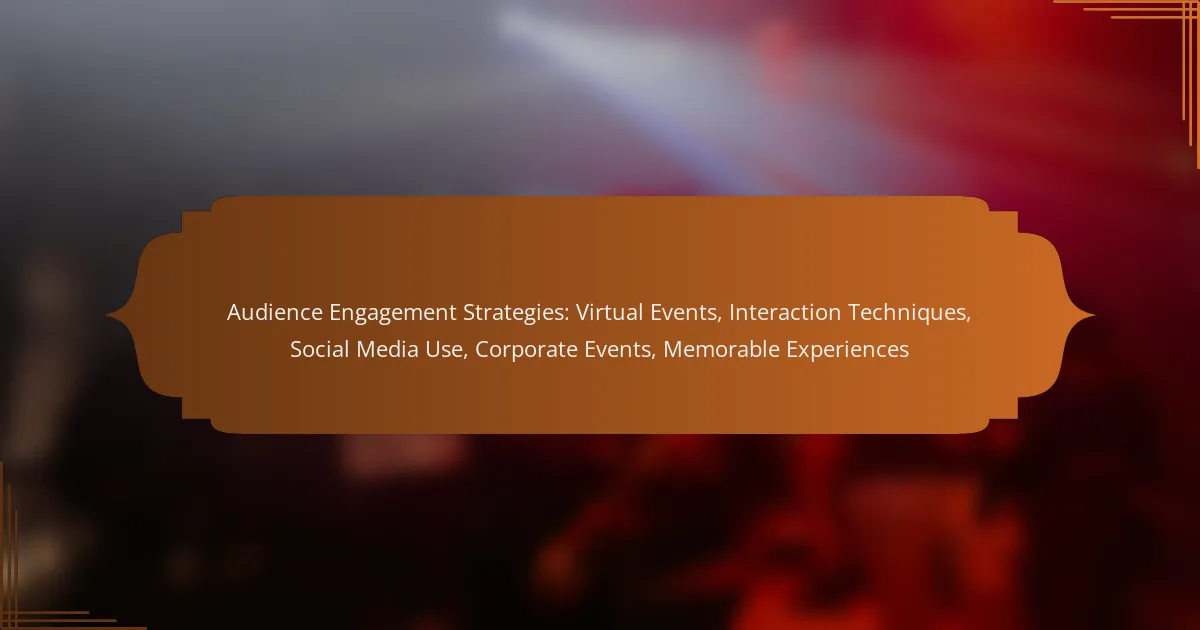In today’s digital landscape, engaging audiences during virtual events is essential for creating memorable experiences. By utilizing interactive techniques and leveraging social media, event organizers can foster participation and build a sense of community, ensuring that attendees remain invested throughout the event. Thoughtful planning and innovative strategies are key to transforming a standard virtual gathering into an engaging and dynamic experience.

How to Engage Audiences in Virtual Events?
Engaging audiences in virtual events requires a blend of interactive elements and thoughtful planning. By incorporating various techniques, you can create a dynamic experience that keeps participants involved and invested.
Utilize interactive polls
Interactive polls are a powerful tool to engage audiences during virtual events. They allow participants to share their opinions in real-time, making them feel more involved in the discussion.
Consider using polls at strategic points to gauge audience sentiment or to gather feedback on topics being discussed. Aim for a mix of quick, fun questions and more serious inquiries to maintain interest.
Incorporate breakout sessions
Breakout sessions enable smaller groups to discuss specific topics in depth, fostering collaboration and engagement. This format encourages participants to share ideas and network more effectively.
Plan breakout sessions with clear objectives and time limits, typically ranging from 10 to 30 minutes. Ensure each group has a facilitator to guide the discussion and keep participants on track.
Leverage live Q&A sessions
Live Q&A sessions provide an opportunity for attendees to ask questions directly, enhancing interaction and clarifying key points. This format can significantly boost engagement by addressing participant interests and concerns.
To maximize effectiveness, allocate sufficient time for Q&A and encourage questions throughout the event. Use a moderator to filter and prioritize questions, ensuring a smooth flow of dialogue.
Use gamification techniques
Gamification techniques, such as quizzes and challenges, can make virtual events more enjoyable and engaging. By incorporating game-like elements, you can motivate participants to actively participate and compete for rewards.
Consider offering prizes for top performers or creating leaderboards to track engagement. Keep the activities simple and relevant to the event’s theme to maintain focus and interest.
Offer networking opportunities
Networking opportunities are essential for fostering connections among participants. Virtual events can facilitate networking through dedicated sessions or informal meet-and-greets.
Implement tools that allow attendees to connect based on shared interests or professional backgrounds. Encourage the use of chat features and video calls to enhance interaction and build relationships.

What Interaction Techniques Drive Engagement?
Interaction techniques that drive engagement focus on creating a dynamic and participatory environment for participants. Effective methods encourage audience involvement, foster connections, and enhance the overall experience during virtual events.
Real-time feedback mechanisms
Real-time feedback mechanisms allow participants to share their thoughts and reactions instantly during an event. Tools like live polls, Q&A sessions, and chat features can be utilized to gauge audience sentiment and adapt content accordingly.
Consider using platforms that support these features, as they can significantly increase engagement levels. For example, incorporating a quick poll at the start of a session can help tailor discussions to the audience’s interests.
Audience-driven content creation
Audience-driven content creation involves actively involving participants in shaping the event’s agenda. This can be achieved through pre-event surveys or live suggestion boards where attendees can propose topics or questions.
By prioritizing content that resonates with the audience, you enhance their investment in the event. For instance, allowing attendees to vote on session topics can lead to more relevant discussions and higher satisfaction rates.
Social media integration
Integrating social media into virtual events can amplify engagement and reach. Encourage participants to share their experiences on platforms like Twitter or Instagram using a dedicated event hashtag.
This not only fosters a sense of community but also attracts a wider audience. Consider displaying a live social media feed during the event to highlight participant interactions and encourage more sharing.
Personalized communication
Personalized communication enhances the connection between hosts and participants. Tailoring messages based on attendee demographics or interests can make interactions feel more relevant and engaging.
Utilize segmentation strategies to send targeted emails or notifications before and after the event. For example, addressing participants by name and referencing their specific interests can significantly improve engagement and retention rates.

How to Use Social Media for Audience Engagement?
Social media is a powerful tool for engaging your audience by fostering interaction and building community. By leveraging various platforms, you can create memorable experiences that resonate with your audience and encourage participation.
Live streaming events
Live streaming events allow you to connect with your audience in real-time, creating an interactive experience. Consider using platforms like Facebook Live, Instagram Live, or YouTube Live to host Q&A sessions, product launches, or behind-the-scenes tours.
Ensure that your live streams are well-promoted in advance to maximize attendance. Engaging with viewers through comments and shout-outs during the stream can enhance the experience and encourage further interaction.
Creating shareable content
Shareable content is key to expanding your reach on social media. Focus on creating visually appealing graphics, informative videos, or entertaining posts that resonate with your target audience.
Consider using formats like infographics, memes, or short clips that are easy to share. Encourage your audience to tag friends or use specific hashtags to increase visibility and engagement.
Engaging with followers through polls
Polls are an effective way to engage your audience and gather feedback. Platforms like Twitter and Instagram offer built-in poll features that allow you to ask questions and receive instant responses.
Use polls to gauge opinions on products, gather insights on preferences, or simply entertain your audience. This not only boosts interaction but also makes followers feel valued and heard.
Utilizing hashtags effectively
Hashtags can significantly enhance your social media visibility and engagement. Research relevant hashtags that align with your content and audience interests to increase discoverability.
Use a mix of popular and niche hashtags to reach a broader audience while still targeting specific groups. Avoid overloading your posts with hashtags; a few well-chosen ones are often more effective than a long list.

What Makes Corporate Events Memorable?
Memorable corporate events stand out due to their unique elements that engage attendees and create lasting impressions. Key factors include the venue, interactive components, quality of speakers, and personalized experiences that resonate with participants.
Unique venue selection
The choice of venue significantly influences the overall experience of a corporate event. Selecting a distinctive location, such as a historic building or a scenic outdoor space, can enhance the atmosphere and make the event more engaging. Consider venues that align with your brand and the event’s theme to create a cohesive experience.
When choosing a venue, assess factors such as accessibility, capacity, and available amenities. A well-located venue can facilitate attendance and encourage networking, while unique features can spark interest and conversation among guests.
Interactive workshops
Interactive workshops engage attendees by encouraging participation and collaboration. These sessions can include hands-on activities, group discussions, or problem-solving exercises that allow participants to apply what they learn in real-time. This approach fosters a sense of community and enhances knowledge retention.
To implement effective workshops, ensure they are well-structured and relevant to your audience’s interests. Providing facilitators who can guide discussions and encourage participation is crucial for maximizing engagement.
High-quality speakers
Inviting high-quality speakers can elevate the impact of your corporate event. Speakers who are experts in their fields can provide valuable insights and inspire attendees with their experiences. Look for individuals who are not only knowledgeable but also engaging and relatable to your audience.
Consider a diverse lineup of speakers to cover various topics and perspectives. This variety can cater to different interests and keep the audience engaged throughout the event.
Customized experiences
Customized experiences tailor the event to the specific needs and preferences of your attendees. This can include personalized agendas, themed activities, or unique giveaways that resonate with participants. Such customization enhances the overall experience and makes attendees feel valued.
To create customized experiences, gather information about your audience beforehand. Surveys or pre-event questionnaires can help identify interests and expectations, allowing you to design an event that truly meets their needs.

What Are the Best Practices for Audience Engagement?
Effective audience engagement involves creating meaningful interactions that resonate with participants. By employing strategic techniques tailored to your audience, you can enhance their experience and foster lasting connections.
Define clear objectives
Establishing clear objectives is crucial for successful audience engagement. These objectives guide the planning and execution of your event, ensuring that every element serves a purpose and aligns with your overall goals.
Consider what you want to achieve—whether it’s increasing brand awareness, generating leads, or fostering community. For instance, if your goal is to boost sales, focus on interactive product demonstrations that encourage participation.
To define your objectives, use the SMART criteria: Specific, Measurable, Achievable, Relevant, and Time-bound. This approach helps clarify your intentions and provides a framework for evaluating success post-event.



